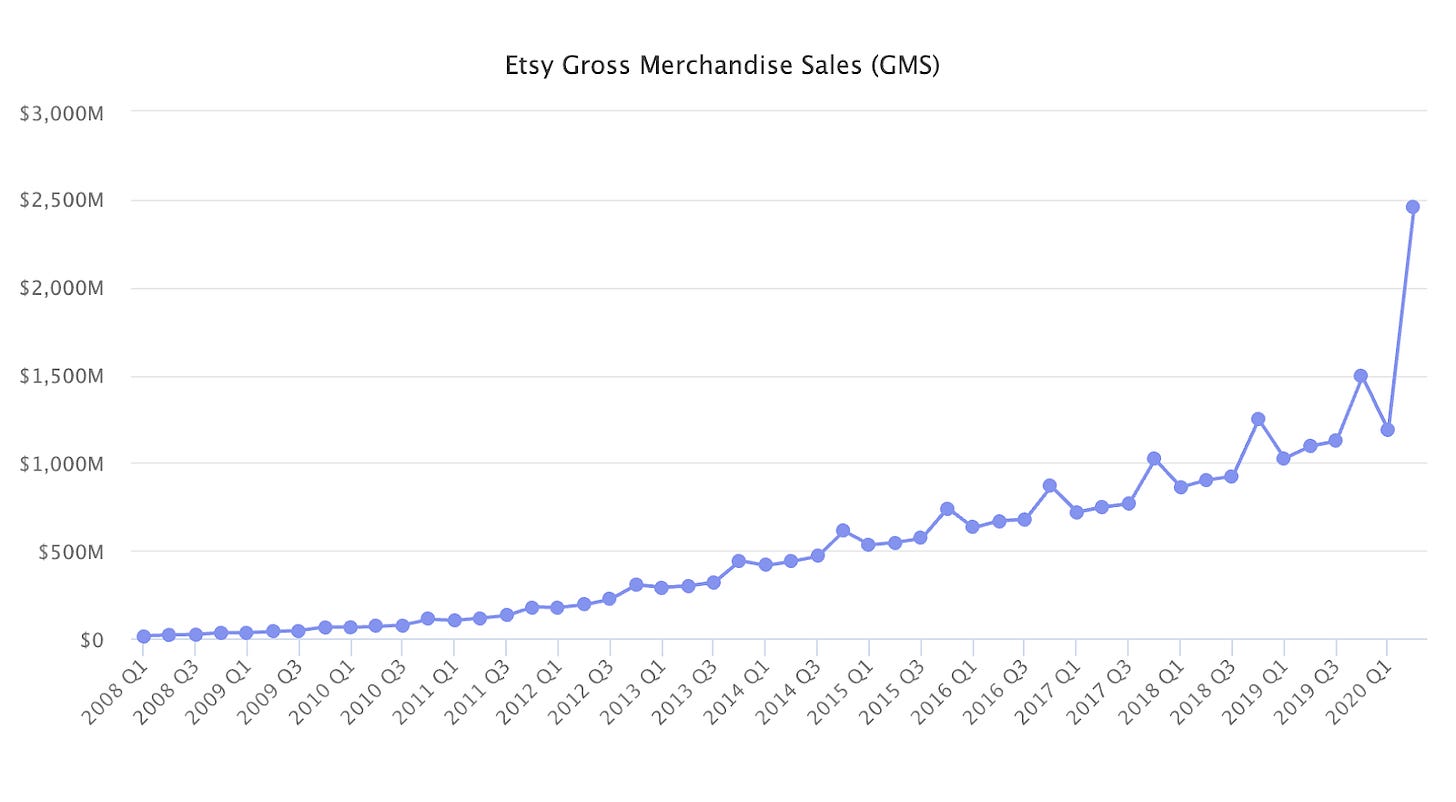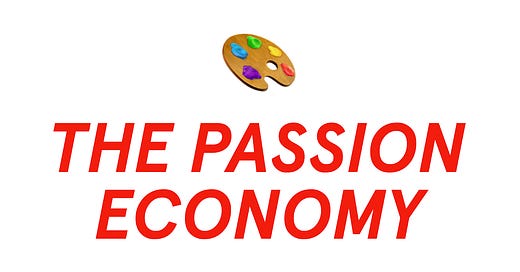
I’m starting a series of posts on the Passion Economy!
The Passion Economy is an ever-growing ecosystem of platforms, tools, and systems that enable a new kind of creation-based entrepreneurship on the internet - the creation and monetization of podcasts, videos, courses, newsletters, communities, or almost any other media!
What’s exciting about the Passion Economy is that it empowers ordinary people to work on their own terms, explore their passions further, and take control of their lives. These are all deeply beneficial to our long-term wellbeing as individuals, and having more happy, purpose-driven, financially stable people can also only be good for our society!
If there’s a way for us to democratize access to entrepreneurship and creation on the internet, shouldn’t we be dedicating more time and energy to it?
We’ll start this series with a question I asked myself recently - why now?
The term “Passion Economy” entered the mainstream of tech and VC with Li Jin’s well-known essay last fall. Since then, there’s been an increased interest in building and getting involved in this space.
But creators have been making a living on the internet for years! Why is now their time to shine and why are opportunities for new creators continuing to grow significantly?
There's no single reason (there rarely is). Instead, it comes down to 4 trends.
The Rise of Creators
Increased Monetization Options
Search for Community
Acceleration by COVID-19
A quick note: there’s lots to talk about for each topic covered - I could write entire essays about some of these paragraphs! So, please forgive any potential lack of detail or simplification - I intend to dive deeper into these in the future. I still appreciate any feedback or ideas!
The Rise of Creators

In the past 10 years, everything around media and creation has gotten bigger. Across media platforms, the numbers of viewers, the number of creators, and the audience of the biggest creators have all grown. As the supply and demand sides of the Passion Economy continue to grow, opportunities for individuals to become creators increase!
Looking at viewer growth, more and more of us are consuming content from independent creators on platforms like YouTube, Twitch, Spotify, etc.. A few examples of that growth: TikTok already has more than 800 Million MAU (!!). From 2016 to 2020, Twitch’s viewing time doubled (source) . Meanwhile in the podcast world, listening increased by 23% in 2019 (source) !
This viewer growth contributed significantly to the rise of superstar creators! In 2011, the #1 YouTuber had 5 million subscribers. Today, there 2,000 channels with an audience that big and the #1 independent YouTuber has 106 million subscribers. On TikTok, there are 50 accounts with more than 20 Million followers. And Joe Rogan, one of the biggest podcasters, has close to 10 million followers on multiple platforms.
As a result, people are consuming more and more great content from superstar creators, some of who are becoming cultural icons! In the same way people want to be Michael Jordan or Taylor Swift, some now aspire to be Casey Neistat or Charli D’Amelio. Being a creator has a lot of aspirational value, particularly amongst kids (~30% of them want to be an influencer!).
On the smaller end of creators, there are over 1 million channels with more than 10,000 subscribers. While these people probably aren’t making as much money as superstar creators, this could be their primary income source, depending on their monetization strategy.
Because of the number of mid-size creators, making a living on the internet also becomes realistic and approachable. People are more likely to hear the story of a mid-size creator and think “Why not me?”
As the number of superstar creators and mid-size creators rises, it’s becoming more socially acceptable to be a creator. And because of increased viewership across platforms, each individual has a better shot at building an audience and, hopefully, making money.
All this creates a self-perpetuating loop! As each platform grows, more viewers join. They give more attention to creators and help them make more money. Then they might see themselves becoming a creator! As they create, they bring in more viewers, more revenue for themselves and the platform, and continue the cycle.

In short, there are more superstar and mid-size creators across all platforms and media. Being a creator on the internet has become more common, more accepted, and something people aspire to be.
Increased Monetization Options
For a while, monetization for creators centered around ads. However, ads and sponsorship don't always provide a reliable wage for many creators, especially those with smaller audiences.
As the platforms grew and more users built larger followings, the concept of "micro influencers" surfaced. Suddenly, more people on Instagram and other platforms could monetize through smaller brand deals, in part by catering to niche audiences. The biggest creators on YouTube previously scored larger brand deals and started product lines like people do now, but with less viewers and less money at stake, it made less sense for businesses to sponsor or invest heavily.
Still, advertising and sponsorship can be unreliable and can require a large following in order to be used as a primary income source.
For example, after one of his videos hit 1 million views, Jack Conte received just $166 from YouTube, which led him to start Patreon. On TikTok, after getting 100M views, 10M likes, and 550,000 followers, Hank Green made a solid $3.60 (from donations).
But through Patreon and other monetization platforms, creators can get paid directly by their fans through subscriptions or product sales rather than relying on ads or brand deals. These income streams usually aren't exclusive, but depending on the creator and audience, one income stream can be much more lucrative than another.
Diversified income streams also create stability for these entrepreneurs, something that’s incredibly important - if you’re leaving a salaried job to grow your audience and make money on the internet, you need to be certain you’ll be able to pay rent next month.

Through these platforms, it’s become easier to make money on the internet and build a stable income stream.
Additionally, a loop forms - as more monetization and creation platforms arise to solve the needs of current creators, more people will feel comfortable starting their own business because the tools now exist. For example, Gumroad simplifies the process of selling an ebook, so people are more likely to consider making and selling an ebook. The same could be said for Etsy and other marketplaces.

What had to be hacked together previously can now be done easily. Everything from building a website, making graphics, selling products, managing administrative work, etc. Li Jin wrote more last week about the unbundling of work and how it will facilitate creation in the Passion Economy.
Search for Community
A third factor in the rise of the Passion Economy is people’s need for community. As platforms like Facebook, Instagram, and Twitter grow, people find them increasingly saturated and noisy. It's no secret that these platforms are not always the best mediums for genuine connection, for belonging, and finding people with the same niche interests.
But people are still looking for these benefits! We all still want to belong and be around like-minded people. As Greg Isenberg points out in his Unbundling of Reddit, this is being spun off into different niche-specific platforms or communities. Reddit itself can only serve so many different niches and use cases through its simple (but efficient) feature set.
Through entertainment, education, or discussion, creators have the power to connect people across the world through their topics of choice. As a result, they have the potential to offer great communities, both directly and indirectly.
Directly, through a Discord, Slack, or a paid community on Circle, Memberful, etc.. Indirectly, communities can be found anywhere, like in the comments of a niche TikTok or of a marble racing video.
On TikTok, we recently saw Step Chickens and other "cults" arise - they even made their own app! People also deeply identify with the communities of their favorite YouTubers, for better (see below) or for worse.

Jelle's Marble Runs (a marble racing channel) has 1.2M subscribers and is sponsored by Last Week Tonight!
As social networks become increasingly noisy, consumers will continue to search for their corner of the internet, their people, regardless of where they’re located. Brands and creators can serve as the lighthouse for those people, intentionally or not.
Acceleration by COVID-19
Finally, the adoption of the Passion Economy, much like everything else on the Internet, has been significantly accelerated by COVID-19 and stay-at-home orders. As we stayed home, we looked for ways to spend our time and money on the internet. We looked for ways to connect with other people like us, and we discovered new creators, platforms, and services. With more time on our hands, more people created or shifted their businesses online, growing the Passion Economy.
While it’s up for debate how much of the recent growth will be sustained, there is no doubt that this year will lead to a significant increase in the number of consumers and creators in the Passion Economy.
Check out this crazy growth!

Gumroad: A 40% jump in creators with a sale in 6 months. $12.5M processed in June, up from $8.3M in January. Gumroad was doing well before and it’s a great company, but the jump in mid-March is just crazy!

Etsy: Total Sales were up 93% from this time last year if you don’t include masks (147% if you do!). There was also a 15% increase in sales per seller, a 35% increase in sellers, and a 41% increase in buyers. More buyers, more sellers, and more money per seller!

Patreon: Estimated creator earnings is up around 50% in 6 months! (per Graphtreon)

Twitch: Huge increases in # of channels and viewers (per TwitchTracker)

E-commerce as a whole
Conclusion
Greater creator visibility, more monetization opportunities, a need for finding community, and COVID-accelerated growth - together these trends have a compounding effect that has caused the growth of the Passion Economy to skyrocket. And we’re just getting started!
The Passion Economy is exciting and important because it offers people an opportunity that did not exist before - the ability to make a living by educating, entertaining and supporting others. They can do what they love and build a life on their terms, offering them one of life’s best resources: freedom.
If you’re seeking that freedom, jump in! Create! Entertain! Teach! There’s always a need for more unique voices, interests, skills. And if you want to create that freedom for others, maybe build something for creators!
There’s no better time than now.
If this was interesting to you, please subscribe as I continue to explore the Passion Economy. Up next: how creators take the leap.
Many thanks to the people who gave amazing in-depth feedback for this essay - Harshita Kaushal, Sandeep Suresh, Pratima Manga, Mikaela Reyes, David Lie-Tjauw, Prerit Oberai, Kanan Rengaraju, Zach Davidson, Melisa Seah, and Kavya Ravikanti.
It wouldn’t have looked anything like this without you!



Thanks for this insightful piece. Any thoughts on how big tech is ultimately helping or hindering the passion economy? Many creators use/need them to help achieve their goals, but dangerous to be too reliant.
Great article bro!